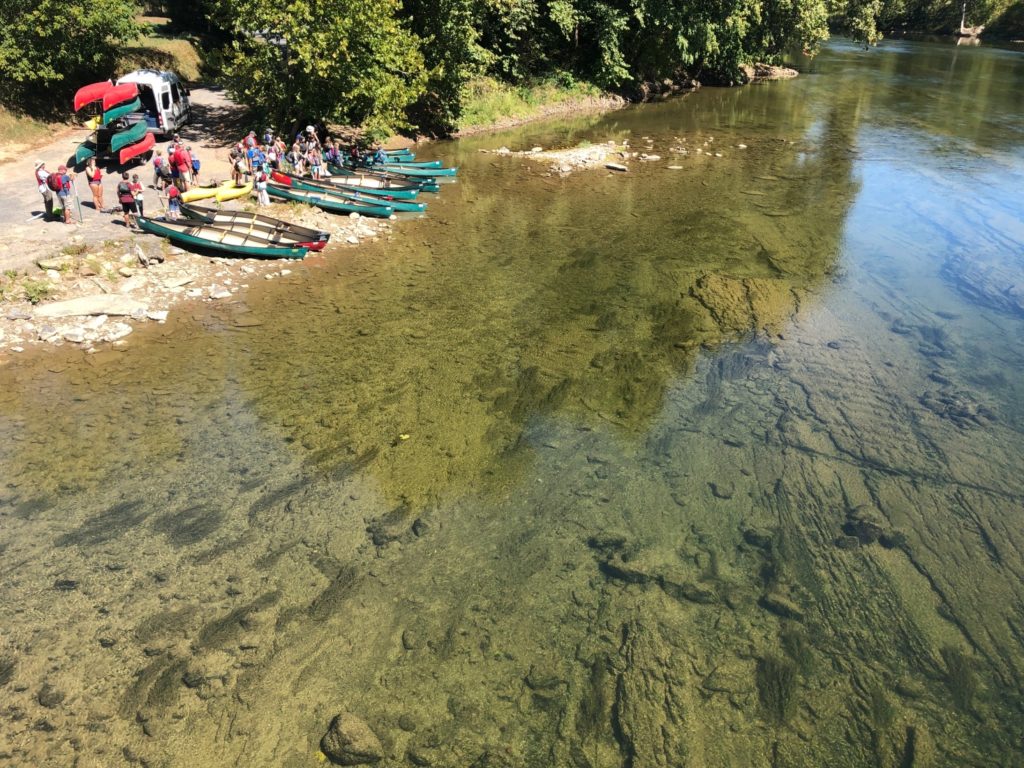We try to inquire “How was your float today?” as folks come off the river. When the river is low, some will say “It was just lovely” and some will say “It was fun, but we kept getting stuck.” The difference will often be in how well you can read the river, where the deep water is, how to navigate a ledge, and how to follow the flow.

RULE OF THUMB #1: Do your homework. Use an outfitter, or know where you’re starting, where you’re finishing, and what’s in-between. Check river gauges or contact an outfitter to ascertain river conditions. And check the weather report while you’re at it.
RULE OF THUMB #2: Be observant when launching! Scan the river. If you can see a place where it looks like it will be difficult to get through due to low or shallow water, then there are bound to be many more just like it along the way, and the river may be too shallow to run today. If, on the other hand, the river is into the brush along the shore, and the current is fast, and there are sizable branches and logs floating, and the river is muddy, then the river may be too high to float safely today.
RULE OF THUMB #3: Avoid strainers! A strainer is any obstacle through which water passes, but you may not, such as a fallen tree, a debris pile, or a low water bridge. Look ahead to spot these obstacles, especially in swift current, and give them a wide berth. Sometimes these obstacles can be stream wide and require a portage.
RULE OF THUMB #4: If the river is high and the current strong, stay near the middle of the river to avoid strainers or overhanging limbs along the banks. I watched a protruding log from the bank sweep everyone off a raft in swift current one day. They were all fine, if a bit shocked. Also, you can often sneak a strong rapid along its edge to avoid the rough water.
RULE OF THUMB #5: Go with the flow! In low water follow the current. You will want to go where most of the water is going. It’s flowing that way because there is a passage for it (and for you). And learn to spot an eddy (a place of calm water out of the current, usually below a rock or ledge). A good paddler can eddy hop up a mild rapid without much effort, and eddies make a good place to pause and wait for the rest of your crew to catch up.
RULE OF THUMB #6: Keep the boat aligned with the flow of the river. Basically, keep the canoe or kayak pointed downstream. Floating sideways dramatically increases you chance of hitting a rock or snag (and taking an unexpected swim).
RULE OF THUMB #7: Follow the “V”. Water flowing through an opening in a ledge or between rocks will often display a distinct “V” pointing down stream. That’s your passage to paradise.
RULE OF THUMB #8: Look for water disturbance, also known a whitewater. Water disturbance may mean water flowing among rocks (don’t go there), or it could be the sign of water moving through an opening and over a drop (you may want to go there). Be observant and learn to tell the difference.
RULE OF THUMB #9: Take wind and current into account. Canoes and rafts have a high wind signature and are subject to being blown about (kayaks less so). Paddling on a windy day is a lot of work let me tell you. Learn to take into account how the prevailing wind in that instant combined with the current under your boat is affecting where you want to go.
Learning to read a river is an art and with practice every trip will become easier and less frustrating (except when it’s windy).
